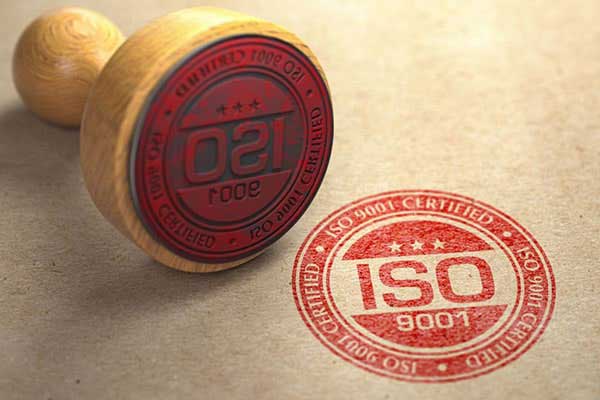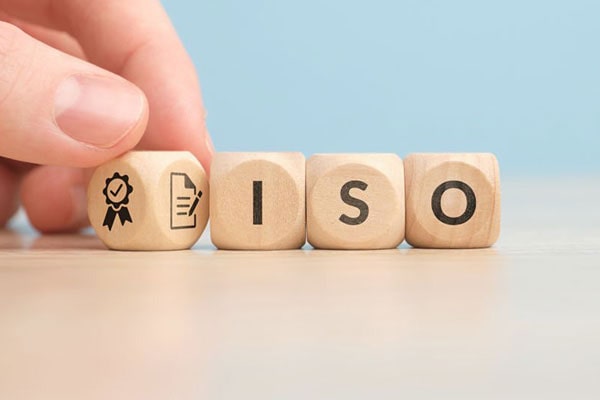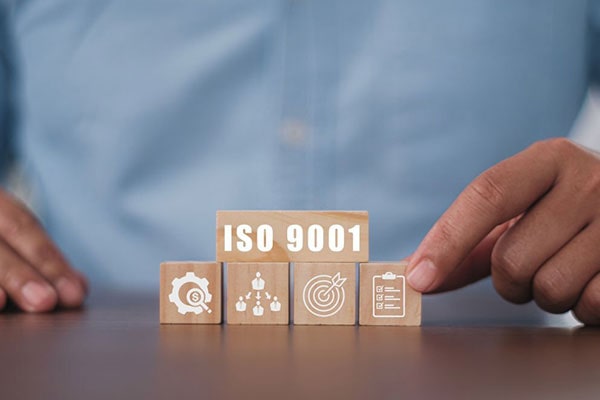iso 9001 Certification

ISO 9001 certification process
To comply with the ISO 9001 standard, your company needs to undergo a certification audit by an independent, objective third-party auditor. Although there are many similarities between your internal audits and the certification audit, the scope and number of audit days are different.
Your company can gain the ISO 9001 certificate once it has completed the audit and all nonconformities have been identified and addressed. Like all the other ISO certificates, the ISO 9001 certificate has a three-year validity period.
However, certification audits cannot be conducted at the drop of a hat. It is necessary for your organisation to complete a full internal audit and accumulate sufficient records for the auditor to verify the effectiveness of your implemented Quality Management System (QMS) to substantiate adherence to all ISO 9001 requirements. As a rule of thumb, one or two months’ worth of records is enough.In the following, we will explain each of the above in full.
Select your registrar
The ISO 9001 registrar is the independent body that appoints an audit team or an auditor to complete your ISO 9001 audit. A national accreditation board accredits experienced and reputable registrars.
The selection of a registrar is an important decision for any organisation as the registrar decides whether your company has performed satisfactorily in the audit.
The registrar is also responsible for maintaining your certificate and its validity. This article explores some of the more pertinent evaluation factors that you will need to consider while selecting and building a long-term relationship with an ISO 9001 certification body (registrar), including:
Accreditation services
Experience
Cost
Timing
Attitude
After choosing the registrar, it is time to prepare for the ISO 9001 audit process.
Preparatory steps for certification audit
Prepare employees across the organisation: Preparing for the certification audit allows the organisation to tidy up different work areas. This time can be used to refine any outdated, uncontrolled or obsolete documents that are floating around your organisation. Additionally, it is essential to prepare your staff to face the auditor by conducting mock interviews and presenting sample questions.
By rehearsing these interview questions, you can potentially reduce your staff’s anxiety and explain what to expect from the audit and the auditor. Here, explaining to your employees that the interaction with the auditor must be truthful and concise is essential. It is not necessary to volunteer additional information.
Some typical auditor questions that should be rehearsed include, “how do you know that you perform your work correctly?” The purpose of this question is that the auditor wants to understand the performance criteria and measurements used in your organisation.
Similarly, another common question is- “how do you contribute to the objectives of your company’s quality policy?” The purpose of asking this question is to check your understanding of the quality policy and its application in daily practice.
It is always beneficial to conduct preparation activities in the days leading up to the audit. Good consultants can help prepare your staff on how to answer questions. If you plan to implement the ISO 9001 by yourself, it is beneficial to consider sharing a short explanatory video with your staff, which covers the purpose, benefits and practises of a QMS. Alternatively, you can utilise a good certification kit with preparation instructions and implementation tips.
The advantages of gaining ISO 9001:2015 accreditation are well researched and documented. Some of the evident benefits include reducing waste by eliminating the number of non-conformity materials in your processes, leading to increased efficiency.
Additionally, the importance of the ISO 9001:2015 accreditation is increasing as many head contractors ask for it during tenders. Yes, the journey to certification is beneficial yet daunting. Acquiring the help of others will make the journey seem less overwhelming.
Why do we need staff engagement?
Implementing the recommendations of ISO 9001 creates changes in the daily task routine. This is especially true for managers or consultants as they have to ensure their team’s readiness for the ISO 9001 audit process.
Additionally, their tasks change quite radically before and after accreditation. As the ISO framework requires organisations to modify, establish, maintain and formally record their business practices to achieve compliance, the work diary of the entire organisation changes.
However, achieving ISO 9001:2015 compliance is a team effort, and one person cannot accomplish this arduous task. Therefore, it is necessary that your team does not change its behaviour. Otherwise, compliance will change.
Unfortunately, in organisations where employees have worked for many years, adapting behaviour to the ISO 9001 recommendations isn’t always straightforward. This brings us to the question, how do we achieve staff engagement?
How do we achieve staff engagement?
The secret to gaining absolute compliance is to win your team over before, during and after implementing the ISO 9001:2015 recommendations. The staff must understand that implementing the standard does not mean that their old ways of working have ended. Still, it is an introduction to how disciplined quality management can improve the performance of a business and ease the workload of the individuals within it.
Although adhering to the recommendation guarantees reaccreditation, real performance improvement occurs through recognised channels. These recognised channels include implementing employee feedback into the processes, measuring and analysing existing processes and evaluating how your employees interact with the processes. Therefore, the actual knowledge lies with your employees themselves.
Winning hearts and minds
To achieve compliance, as a manager, you would have given your team members clarity regarding the roles and responsibilities, training schedule and dates for individual appraisal.
All of these powerful instruments are great information-gathering tools in themselves. If these tools have been effectively put in place, your employees will understand that implementing the QMS is not a “box ticking” exercise that should be taken lightly.
Instead, they will understand that the QMS implementation is a method to encourage achievement against specific tasks. The training programmes created help to facilitate improvement in task execution, and the feedback sessions help to ensure that employee feedback is appropriately gathered and incorporated in the process improvement steps.
As a result, employees understand that these processes are aimed at their individual personal development.
To help facilitate learning and encourage easy assimilation, it is beneficial to take some critical elements of the ISO 9001 standard and share them with your staff. Examples can include customer feedback, employee experiences and changes in business performance.
Out of these elements, customer feedback can be thought to be the most inspiring as any business aims to acquire customer satisfaction. Moreover, employees understand that unsatisfied customers bring down sales, and happy customers lead to an increase in new sales and repeat business.
By sharing the key aspects of ISO 9001, your employees will understand that the new changes within your organisation enhance customer satisfaction.
Change in behaviours, benefits and gaining certificates.
Sharing these benefits would help you see a visible change in the behaviour of your team, but you, as a leader, should drive change through your actions.
ISO 9001:2015 urges top management to become the drivers of continual improvement. Hence, to show your commitment to the change, hold daily meetings where you showcase specific and time-bound targets. Provide clarity about who holds responsibility for each process and each achievement.
Ensure that these changes are formally documented, not only for ISO compliance but also for the good of your team. Review the feedback from your team and adjust your processes. Acquiring accreditation should become a team goal and not just a personal one.
Remember, acquiring the ISO 9001:2015 accreditation is not just another certificate on your wall but a method to revolutionise how your business works.
Pass the stage one and stage two audits
The certification audit is divided into two phases, where during the first stage, a review of the documentation takes place, and during the second stage, your work processes are analysed. The stage one audit is conducted remotely, whereas the stage two audit can be conducted remotely or on-site, depending upon your registrar.
In most cases, only a few minor issues are covered during the audit. Unless the issues uncovered are serious nonconformities, you will only need to correct them and inform your registrar before your ISO 9001 certificate can be issued. However, if you encounter serious nonconformities, the registrar will conduct a follow-up audit before deciding if your company can be certified.
Congratulations, if everything goes well, you will receive ISO 9001 certification. But this is just the beginning of the story. Now you have to market your certificate in the best way.
Market your certification
There are numerous marketing benefits that your ISO certificate can provide, including increased prestige, accessibility to newer markets and customer acquisition. It is beneficial to start leveraging your ISO 9001 registration through a press release and targeted customer notifications. Moreover another strategy is to add the certification logos to your business cards, advertisements and stationery. Additionally, local customers can be informed about your success through a banner outside your premises.
Why market your ISO certification?
The most potent factor in building trust with potential as well as current customers is sharing the benefits in an easily digestible manner. Unfortunately, these benefits often take the form of competitive pricing or a world-class experience. However, certification marketing should not be overlooked in its ability to attract new clients as it is the most flexible tool in your tool belt of benefits. One of the crucial components of purchasing decisions is choosing the quality of the product. Hence, it becomes essential to convey your ability to deliver consistent quality.
Here are three simple marketing techniques that you can apply to promote your ISO certification:
- Add the ISO certification logo/badge to your website. There are several examples of how to incorporate specific badges on the internet.
- Add ISO certificate logos/badges to your business cards or brochures. This is because the visual representation of the ISO certification on brochures, presentations, marketing material or business cards is encouraging and reassuring to new clients.
- Identify an appropriate section on your website to provide a link to the PDF of your official certificate of approval. Depending upon your website and where it displays quality-related information, this link may be placed under quality or the “about us” section. Some organisations choose to put a link directly on the homepage.
- Announce your ISO certification achievement on social media. It is always helpful to post an update on your LinkedIn company page or write an announcement on Twitter. Utilising relevant hashtags before each mention of the quality standard helps to categorise these tweets so that they show up more efficiently in a Twitter search.
Maintain registration
It is important to remember that accreditation is not a one-off event, after which the chapter on ISO 9001 can be closed. Many companies make the mistake of losing focus after acquiring the certificate. To ensure the continued implementation of continual improvement strategies isin your organisation, your registrar will conduct periodic surveillance audits.
The frequency of the surveillance audits is usually once or twice a year. An automatic improvement mechanism is created if you have implemented your quality management system appropriately. Therefore, just by making sure that your ISO processes remain implemented and by continuing your internal audits, you will notice how your company’s performance improves and is reflected in the bottom line.
How to maintain your ISO 9001-based QMS after certification
Many organisations mistake resting on their laurels after implementing ISO 9001 and clearing the certification audit. However, the actual job begins after the QMS is implemented. After successfully implementing the QMS, you must begin to maintain it. If you have adhered to the recommendations outlined in the standard, passing the certification would not have been a problem or a stressful activity. Similarly, adhering to the standard’s recommendations will ensure that your surveillance audits remain hassle-free. Many times, companies make the mistake of not doing the necessary work before the surveillance audits.
This includes not gathering the necessary information to perform the required activities or providing insufficient data. At this point, many organisations resort to calling in a consultant to fix their problem and help them formally pass the surveillance audit. This is only a quick-fix solution and does not bring any real value to the company. Therefore, it is beneficial to implement the standard’s recommendations for several years to harvest the real benefits for the company, its people and the QMS.
Go from plain to do phase.
The development of procedures is more accessible than their implementation. They are ensuring that the procedures are followed more time than creating or writing them. Once the procedures are formally documented, it will take time to train employees to follow them. Of course, most of the activities were already performed even before the standard, but the new ones must be adopted by the employees. To ensure timely implementation, training will address any gaps and raise awareness of processes within the employees. Additionally, you will be required to fill in some records and keep track of activities so that appropriate data is available for analysis during management reviews.
Training
You will require additional training for the employees to implement the new activities properly. The best part about the standard is that it provides the framework on how to identify the gaps within the training and the needs of the employees and plan the training programmes in accordance. Additionally, the channel also provides metrics to measure training effectiveness. This systematic approach enhances competence throughout the organisation and allows for measuring training effectiveness.
Control of outsourcing partners and suppliers
In the majority of the cases, organisations do not have a structured approach to controlling their outsourcing. In fact, in many cases, organisations rely on assumptions or gut feelings. The ISO 9001 provides different criteria to select suppliers, helping organisations to stop, introspect and define what they expect from the supplier. Additionally, if the transformation procedure has already occurred, the standard provides you with the metrics to evaluate suppliers at planned intervals.
Monitoring and measuring
Monitoring and measuring should provide information on the status of your QMS, process or activities. If the monitoring and measuring processes are set up appropriately, they will provide you with valuable information and insight into the performance of your processes.
Customer satisfaction
One of the most critical principles behind ISO 9001 is customer focus. The attention to customer focus is demonstrated through the standard’s recommendation of regularly monitoring and measuring customer satisfaction. It is necessary for the company to define how and when they will conduct surveys to determine their level of customer satisfaction. Additionally, the standard urges organisations to have relevant information on how the customer perceives their organisation.
Check and act phases.
Gathering relevant information about the QMS through monitoring and measuring the processes will allow top management to exercise the last principle of ISO 9001, namely implementing evidence-based decision-making. By conducting detailed internal audits, the top management is provided with information about the level of compliance and the condition of the entire system. Utilising this information, the top management can conduct value-added management reviews and make decisions that lead to continual improvement.
External audit without stress
By adhering to all these elements, the actual effectiveness of QMS can be achieved. An effective QMS works in favour of the company, helping to improve quality and reduce costs by driving efficiency. When these elements are kept in place, you will fly through your external audit without stress.
Let's talk and get ISO 9001 certified
Being ISO 9001 certified makes your organisation more competitive by helping you improve your operational efficiency and enhance the overall consistency of your product/services. This boosts your business credibility and authority, allowing you to soar to heights.
FAQ
Frequently asked questions about ISO 9001 certification
The last stage of obtaining ISO 9001 is preparation for certification.
We have special services for Australian companies. Just contact us to get ISO 9001 certificate.
Typically, it takes between 3 and 6 months to get the ISO 9001 certified status. But we will help you to get the certificate in the shortest possible time.















